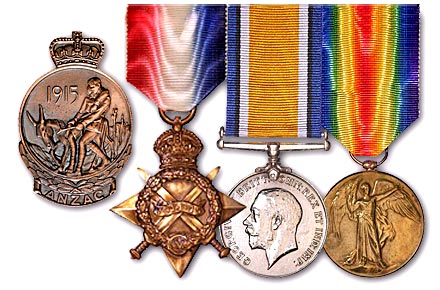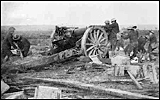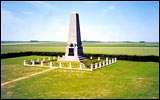| Sidney's Homepage | |||||||||||||||
|

|
||||||||||||||
Gallipoli Medal | 1914/15 Star | British War Medal | Victory Medal |
|||||||||||||||
| MEDALS AWARDED IN WWI | |||||||||||||||
| ANZAC Commemorative Medallion - British Commonwealth War and Campaign Medals | |||||||||||||||
| The ANZAC Commemorative Medallion and Badge | |||||||||||||||
In 1967 the Australian and New Zealand governments jointly agreed to issue an ANZAC Commemorative Medallion to all surviving veterans who had served on the Gallipoli Peninsula, or in direct support of the operations from close off shore, at any time during the period from the first ANZAC Day in April 1915 to the date of final evacuation in January 1916 or to next of kin of veterans. The ANZAC Commemorative Medallion was was not designed to be worn. |
|||||||||||||||
| The 1914 - 15 Star | |||||||||||||||
About this medal This medal was awarded to servicemen and servicewomen who served between August 1914 and December 1915, provided they had not qualified for the 1914 Star. This included service at Gallipoli. Initially this medal was not going to be awarded for service at Gallipoli. Instead, it had been proposed by Lieutenant General Birdwood in October 1917 that a Gallipoli Star (originally to be called the ANZAC Star) should be awarded to members of the Australian Imperial Force and 1NZEF who served at Gallipoli. King George V approved the idea the following month. However, by August 1918 when the design of the star and the conditions for award had been finalised, and stocks of ribbon forwarded to New Zealand and Australia, the proposal was reviewed by the British government following criticism from both members of Parliament and the media in the United Kingdom, who were uneasy about British and other forces of the Empire being ineligible for the proposed star. After consultation with the Australian and New Zealand governments, the British War Cabinet agreed that the 1914-15 Star would be awarded to all personnel who had served at Gallipoli. (Source: Ian McGibbon (ed), The Oxford Companion to New Zealand Military History (Oxford University Press, Auckland, 2000), p.226). In 1967 the Australian and New Zealand governments jointly agreed to issue an ANZAC Commemorative Medallion (which was not designed to be worn) to all veterans and the next of kin of veterans who has served at Gallipoli. |
|||||||||||||||
| Clasps and Bars No clasps or bars were issued for this medal. |
|||||||||||||||
| The British War Medal | |||||||||||||||
About this medal This medal was instituted in 1919 to recognise the successful conclusion of the 1914 - 18 War. Its coverage was later extended to recognise service until 1920, mainly in mine clearing operations at sea. |
|||||||||||||||
Clasps and Bars Rather unusually, no clasps were issued for this medal, although it was originally intended to do so. However, there were so many operational areas and theatres of war to be included, that the proposal was abandoned as impractical. |
|||||||||||||||
| The Victory Medal | |||||||||||||||
About this medal This medal was issued to all those who had already qualified for the 1914 or 1914-15 Stars, and to most persons who had already qualified for the British War Medal. The Victory Medal is distinguished by its unique ‘double rainbow' ribbon. Approximately 6 million of these medals were issued to military personnel from the British Empire. This medal is sometimes referred to as the "Allied War Medal", because the same basic design and the double rainbow ribbon were adopted by 13 other Allied nations (though the United States of America alone issued their medal with campaign clasps). The Union of South Africa produced a version of the medal with a reverse text in English and Dutch (not Afrikaans, as is often stated). |
|||||||||||||||
| Clasps and Bars No clasps or bars were issued for The Victory Medal. |
|||||||||||||||


